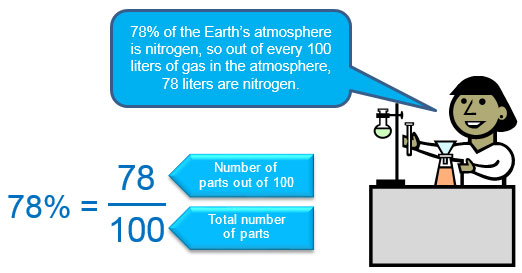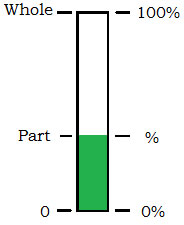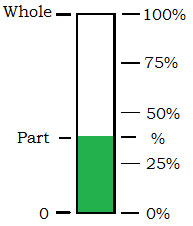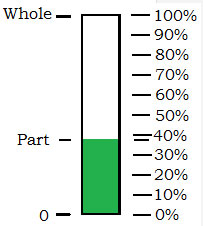
Previously, you have learned that a percent is a ratio of the part of a group to the size of the whole group, in terms of parts per 100.

In this section, you will use ratios to represent a percent, part, and whole.
There are several different ways to represent a percent. One way is to use a percent bar. A percent bar is a bar that is marked with percents on one side and the actual part and whole on the other.


The images to the left and right represent the same part of the whole. However, the image on the left shows fewer division marks than the image on the right. From these two images, you can determine more precisely from the image on the right that the green part covers about 38% of the whole bar. The more equally divided marks you can show on your percent bar, the more acurate you will be with your answer.

In the following activity, you will practice using a percent bar to find the value of a percent, given values for the part and the whole.
![]() Drag each green bar onto the empty percent bar, and then click the appropriate place on the percent scale on the right side of the bar.
Drag each green bar onto the empty percent bar, and then click the appropriate place on the percent scale on the right side of the bar.
Copy the following table into a word processing or spreadsheet app or program. Use the results from the interactive to complete the table.
Part |
Whole |
Percent |
Percent over 100
Percent
100
|
Part over whole
Part
Whole
|
2 |
40 |
|||
4 |
40 |
|||
5 |
40 |
|||
8 |
40 |
|||
10 |
40 |
|||
20 |
40 |
|||
30 |
40 |
|||
40 |
40 |
Part |
Whole |
Percent |
Percent over 100
Percent
100
|
Part over whole
Part
Whole
|
2 |
40 |
5% |
5 over 100
5
100
|
2 over 40
2
40
|
4 |
40 |
10% |
10 over 100
10
100
|
4 over 40
4
40
|
5 |
40 |
12.5% |
12.5 over 100
12.5
100
|
5 over 40
5
40
|
8 |
40 |
20% |
20 over 100
20
100
|
8 over 40
8
40
|
10 |
40 |
25% |
25 over 100
25
100
|
10 over 40
10
40
|
20 |
40 |
50% |
50 over 100
50
100
|
20 over 40
20
40
|
30 |
40 |
75% |
75 over 100
75
100
|
30 over 40
30
40
|
40 |
40 |
100% |
100 over 100
100
100
|
40 over 40
40
40
|

Use your completed table and the interactive to answer the questions that follow.
Interactive popup. Assistance may be required.
The two ratios for each percent bar are equivalent.
Interactive popup. Assistance may be required.
The part and whole have the same ratio as the percent and 100, which is the number of parts per 100.
You can represent these equivalent ratios using what is sometimes called the percent proportion. The percent proportion represents two equivalent ratios. The first ratio is the percent, which is the number of parts per 100. The second ratio is the size of the part to the size of the whole.
Suppose you know two of the following pieces of information: part, whole, or percent. How could you use the percent proportion to set up an equation to solve for the third piece of information?
![]() Use the interactive below to practice setting up a proportion that you can use to solve a percent problem. Drag the tiles representing the numbers to their appropriate place in the percent proportion below.
Use the interactive below to practice setting up a proportion that you can use to solve a percent problem. Drag the tiles representing the numbers to their appropriate place in the percent proportion below.
Travis is buying a pair of running shoes at a clearance sale. The shoes originally cost $36.00, and Travis saved a total of $9.00 because of the sale. What percent of the original cost did Travis save?
For each of the situations below, set up but do not solve, a proportion that you could use to solve the problem.
Interactive popup. Assistance may be required.
Identify the percent, part, and whole, and use them to write the percent proportion.
Interactive popup. Assistance may be required.
Identify the percent, part, and whole, and use them to write the percent proportion.
Interactive popup. Assistance may be required.
Identify the percent, part, and whole, and use them to write the percent proportion.
Interactive popup. Assistance may be required.
Identify the percent, part, and whole, and use them to write the percent proportion. Notice that you are given the percent of students who are Hispanic, but the question asks for the number of students who are NOT Hispanic, so you will need to use the percent that is the complement of what you are given.